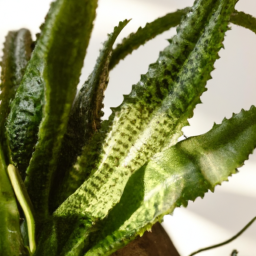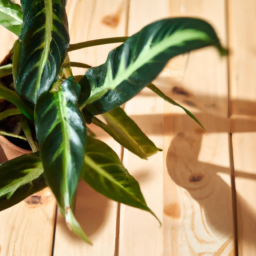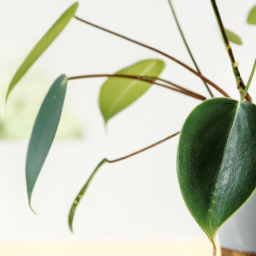
Are you looking to brighten up a shady corner of your home with some indoor plants? If so, you’re in the right place! In this blog post, we’ll explore the world of indoor plants that thrive in low-light conditions. So, if you’ve been wondering “What indoor plants do well in shade?” keep reading to discover some great options for adding greenery to your home, even in the darkest corners.
Best Indoor Plants for Low Light Environments
When it comes to choosing indoor plants for low light environments, it’s important to select varieties that can thrive without direct sunlight. While many plants require ample sunlight to photosynthesize and grow, there are several options that can do well in shaded areas. In this guide, we will explore some of the best indoor plants for low light environments and provide tips on how to care for them effectively.
Peace Lily
Peace lilies are popular indoor plants known for their elegant white flowers and dark green leaves. They are well-suited for low light environments and can thrive in shady corners of your home. Peace lilies are also excellent air purifiers, helping to remove toxins from the air and improve indoor air quality.
When caring for a peace lily in a low light environment, it’s important to water it regularly and keep the soil consistently moist. Avoid overwatering, as this can lead to root rot. Peace lilies also benefit from occasional misting to increase humidity levels around the plant. Fertilize your peace lily every few months to promote healthy growth and flowering.
If you notice your peace lily’s leaves turning yellow, it may be a sign of overwatering or inadequate light. Move the plant to a brighter location and adjust your watering schedule accordingly. With proper care, your peace lily can thrive in low light environments and bring beauty to your home.
Snake Plant
Snake plants, also known as mother-in-law’s tongue, are hardy indoor plants that can tolerate low light conditions. They have tall, upright leaves that add a touch of elegance to any space. Snake plants are also excellent air purifiers, making them a great choice for bedrooms and other areas where air quality is a concern.
When caring for a snake plant in a low light environment, it’s important to let the soil dry out between waterings. Snake plants are drought-tolerant and can withstand periods of neglect, making them ideal for busy plant owners. Avoid overwatering, as this can lead to root rot and other issues.
Snake plants prefer indirect sunlight but can also thrive in low light conditions. If your snake plant starts to lean towards the light, rotate it periodically to promote even growth. Fertilize your snake plant sparingly, as too much fertilizer can harm the plant. With minimal care, your snake plant can thrive in a shady corner of your home.
ZZ Plant
ZZ plants, also known as Zamioculcas zamiifolia, are popular indoor plants that can thrive in low light environments. They have glossy, dark green leaves that add a touch of sophistication to any room. ZZ plants are drought-tolerant and can withstand neglect, making them ideal for beginners or busy plant owners.
When caring for a ZZ plant in a low light environment, it’s important to let the soil dry out between waterings. ZZ plants are sensitive to overwatering and can develop root rot if the soil is too wet. Place your ZZ plant in a location with indirect sunlight, such as a north-facing window or a shaded corner.
ZZ plants are slow growers and do not require frequent fertilization. Feed your ZZ plant with a balanced houseplant fertilizer every few months during the growing season. Prune any yellow or damaged leaves to promote healthy growth. With minimal care, your ZZ plant can thrive in a low light environment and bring beauty to your home.
In conclusion, there are several indoor plants that can thrive in low light environments. Peace lilies, snake plants, and ZZ plants are excellent choices for shady corners of your home. With proper care and attention, these plants can thrive and bring beauty to your indoor space. Remember to water your plants appropriately, provide adequate light, and fertilize them sparingly to promote healthy growth. Enjoy the beauty and benefits of indoor plants in your low light environment.

Top Shade-Tolerant Indoor Plants for Your Home
Understanding Shade-Tolerant Plants
When it comes to choosing indoor plants for your home, it’s important to consider the amount of light they will receive. While many plants thrive in bright, indirect sunlight, there are also plenty of options for those darker corners of your home that don’t get as much natural light. Shade-tolerant plants are a great choice for these spaces, as they can thrive in low-light conditions and still bring a touch of greenery to your home.
One key factor to keep in mind when selecting shade-tolerant plants is the difference between low light and no light. While no plant can survive without any light at all, there are some varieties that can tolerate lower light levels than others. These plants have adapted to thrive in shady conditions, making them perfect for indoor spaces with limited sunlight.
When choosing shade-tolerant plants for your home, it’s also important to consider the specific conditions of your space. Some plants may do well in bright, indirect light, while others can thrive in low-light conditions. By understanding the needs of different plants and matching them to your home’s lighting situation, you can create a thriving indoor garden that brings life to even the darkest corners of your home.
Top Shade-Tolerant Indoor Plants
1. **Snake Plant**: Also known as mother-in-law’s tongue, the snake plant is a popular choice for low-light spaces. This hardy plant can tolerate a range of light conditions, making it perfect for shady corners. Snake plants are also known for their air-purifying qualities, making them a great choice for improving indoor air quality.
2. **ZZ Plant**: The ZZ plant is another great option for low-light spaces. This plant has glossy, dark green leaves that add a touch of elegance to any room. ZZ plants are also incredibly low-maintenance, making them perfect for beginners or those with busy schedules.
3. **Peace Lily**: Peace lilies are known for their beautiful white flowers and lush green leaves. These plants can thrive in low-light conditions, making them a great choice for shady areas of your home. Peace lilies are also excellent air purifiers, making them a healthy and beautiful addition to any indoor space.
4. **Spider Plant**: Spider plants are a classic choice for indoor gardens, thanks to their easy care and striking appearance. These plants can thrive in a range of light conditions, including low light. Spider plants are also known for their air-purifying qualities, making them a great choice for improving indoor air quality.
5. **Pothos**: Pothos plants are another popular choice for low-light spaces. These plants have trailing vines and heart-shaped leaves that add a touch of greenery to any room. Pothos plants are incredibly easy to care for and can thrive in a variety of light conditions, making them a versatile option for indoor gardens.
By choosing shade-tolerant plants for your home, you can bring the beauty of nature into even the darkest corners of your space. With the right care and attention, these plants can thrive in low-light conditions and add a touch of greenery to your indoor environment. So next time you’re looking to brighten up a shady corner, consider adding one of these top shade-tolerant indoor plants to your home.

How to Choose and Care for Indoor Plants that Thrive in Shade
Understanding the Different Types of Shade
When it comes to choosing indoor plants that thrive in shade, it’s important to understand the different types of shade that you may encounter in your home. There are three main types of shade: full shade, partial shade, and dappled shade. Full shade means that an area receives little to no direct sunlight, while partial shade means that an area receives some direct sunlight for part of the day. Dappled shade refers to an area that receives filtered sunlight through trees or other objects.
When selecting indoor plants for a shaded area, it’s important to consider the specific type of shade that the plant will be exposed to. Some plants may do well in full shade but struggle in partial shade, so be sure to choose plants that are well-suited to the specific conditions of your home.
Choosing the Right Indoor Plants for Shade
When choosing indoor plants that thrive in shade, there are several factors to consider. First, consider the light requirements of the plant. Some plants, such as peace lilies and snake plants, are well-suited to low light conditions and can thrive in shady areas. Other plants, such as spider plants and pothos, prefer brighter light but can still do well in partial shade.
In addition to light requirements, consider the size of the plant and the space available in your home. Some indoor plants, such as ferns and palms, can grow quite large and may not be suitable for small spaces. If you have limited space, consider smaller plants such as spider plants or pothos that can thrive in shade.
Finally, consider the care requirements of the plant. Some indoor plants are low-maintenance and require minimal care, while others may need more attention. Choose plants that fit your lifestyle and schedule to ensure that they thrive in your home.
Caring for Indoor Plants that Thrive in Shade
Once you’ve chosen the right indoor plants for shade, it’s important to provide them with the proper care to ensure that they thrive. Here are some tips for caring for indoor plants that do well in shade:
1. Watering: Most indoor plants that thrive in shade prefer consistently moist soil. Water your plants when the top inch of soil feels dry to the touch, but be careful not to overwater as this can lead to root rot.
2. Humidity: Many indoor plants that do well in shade prefer high humidity levels. To increase humidity, mist your plants regularly or place a humidifier near them.
3. Fertilizing: Indoor plants that thrive in shade may benefit from regular fertilization during the growing season. Choose a balanced liquid fertilizer and follow the instructions on the label.
By choosing the right indoor plants for shade and providing them with the proper care, you can create a lush and thriving indoor garden that brightens up even the darkest corners of your home.
Let’s wrap up what we learned
If you have a shady corner in your home that could use some greenery, don’t worry – there are plenty of indoor plants that thrive in low light conditions. One popular choice is the peace lily, which is known for its beautiful white flowers and ability to purify the air. Peace lilies can tolerate low light levels and are relatively low maintenance, making them a great option for beginners.
Another great option for shady areas is the snake plant, also known as mother-in-law’s tongue. This plant is incredibly resilient and can survive in almost any lighting condition, including low light. Snake plants are also known for their air-purifying qualities, making them a great addition to any room in your home. Other shade-loving indoor plants include pothos, spider plants, and ferns, all of which can add a touch of green to even the darkest corners of your home. So don’t let a lack of sunlight stop you from bringing some greenery indoors – there are plenty of plants that will thrive in shade.
Top FAQs:
Q1: What are some indoor plants that do well in shade?
A1: Some indoor plants that thrive in low light conditions include pothos, snake plant, peace lily, ZZ plant, and spider plant.
Q2: How often should I water indoor plants that do well in shade?
A2: It’s important to let the soil dry out between waterings for shade-loving plants. Check the soil moisture with your finger before watering to avoid overwatering.
Q3: Do shade-loving indoor plants require any special care?
A3: While shade-loving plants are more forgiving of low light conditions, they still need proper care. Make sure to dust their leaves regularly, provide occasional fertilization, and repot them when needed.
Q4: Can I place shade-loving indoor plants near a window?
A4: Yes, you can place shade-loving plants near a window, but make sure they are not in direct sunlight. Filtered or indirect light is best for these plants.
Q5: Are there any benefits to having indoor plants that do well in shade?
A5: Yes, shade-loving indoor plants can help improve air quality, reduce stress levels, and add a touch of greenery to your space without requiring direct sunlight.
Dr. Olivia Green is a botanist with over two decades of experience in indoor plant cultivation. She holds a Ph.D. in Plant Biology and has dedicated her career to researching plant behavior in controlled environments. Dr. Green is passionate about helping plant enthusiasts master the art of indoor gardening through her extensive knowledge and practical insights.


